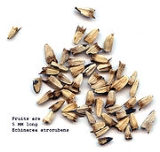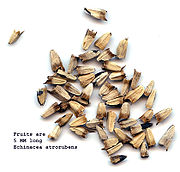
Echinacea atrorubens
Encyclopedia

Perennial plant
A perennial plant or simply perennial is a plant that lives for more than two years. The term is often used to differentiate a plant from shorter lived annuals and biennials. The term is sometimes misused by commercial gardeners or horticulturalists to describe only herbaceous perennials...
growing from 50 to 90 cm tall from elongate-turbinate root
Root
In vascular plants, the root is the organ of a plant that typically lies below the surface of the soil. This is not always the case, however, since a root can also be aerial or aerating . Furthermore, a stem normally occurring below ground is not exceptional either...
s that are sometimes branched. The stem
Plant stem
A stem is one of two main structural axes of a vascular plant. The stem is normally divided into nodes and internodes, the nodes hold buds which grow into one or more leaves, inflorescence , conifer cones, roots, other stems etc. The internodes distance one node from another...
s and foliage are usually hairy with appressed to ascending hairs 1.2 mm long (strigose), rarely some plants are glabrous. Stems light green or tan mottled in color. The basal leaves have petioles
Petiole (botany)
In botany, the petiole is the stalk attaching the leaf blade to the stem. The petiole usually has the same internal structure as the stem. Outgrowths appearing on each side of the petiole are called stipules. Leaves lacking a petiole are called sessile, or clasping when they partly surround the...
0–12(–20) cm long and leaf blades typically 3 or 5-nerved, usually linear or lanceolate, rarely ovate, 5–30 cm long and 0.5–3 cm wide, the margins are normally entire. The flowering stems or peduncles
Peduncle (botany)
In botany, a peduncle is a stem supporting an inflorescence, or after fecundation, an infructescence.The peduncle is a stem, usually green and without leaves, though sometimes colored or supporting small leaves...
are 20–50 cm long ending with one flower head typically. The flowering "cones" with paleae 9–15 mm long, with the ends red to orange-tipped, usually straight, and prickly-pointed. Ray flower corollas purple colored or rarely pink or white. Discs or cones are ovoid to conic in shape and 25–35 wide and 20–40 mm tall. Disc corollas 4.5–5.5 mm long with lobes greenish to pink or purple. Seed cypselae tan in color and 4–5 mm long with faces finely tuberculate, glabrous. This species has 11 chromosomes.
Flowering occurs in late spring. Native to Kansas, Oklahoma and parts of Texas were it is found growing in dry soils around limestone or sandstone outcroppings and prairies.
Synonyms:
Rudbeckia atrorubens Nuttall, J. Acad. Nat. Sci. Philadelphia 7: 80. 1834

